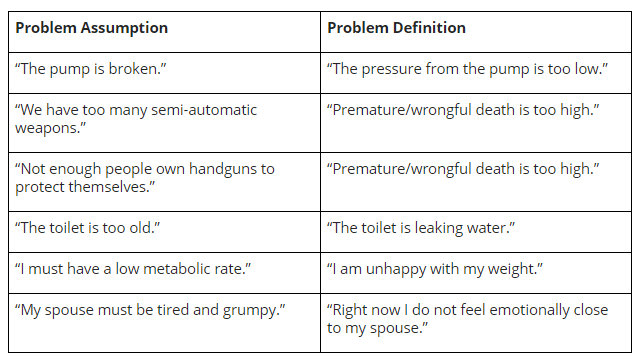Know What Problem You’re Solving
Episode #4 of the course Problem solving by Nat Greene
Intrepid problem solvers,
Yesterday we talked about how to find and run towards the unknown when solving your problem. Today you’ll learn how to set yourself up to succeed by really getting your problem definition right. Knowing what problem you are solving might seem so obvious that it isn’t worth your time to even think about it, but the very willingness to ignore this behavior sends many problem-solving efforts into the dustbin. The problem doesn’t get solved, or the organization just throws resources to fix something that was never the problem in the first place.
You should put great care into defining the problem in an accurate and precise way, as a direct and measurable observation of the problem. It must be clear how solving it relates directly to your goals. And it must absolutely not be an assumption or a disguised guess.
How to Poorly Define a Problem
A bad problem definition is a particularly insidious form of guessing. When a “problem definition” is an assumption about the solution, it puts blinders on the problem solver’s eyes, and they gallop straight towards the entirely wrong area with unjustified confidence. This leads to investing resources—time, money, emotional energy, etc.—into something that won’t solve our problem at all or might even make it worse.

Great problem solvers avoid being trapped into solving the wrong problem by defining the problem without prejudice or assumption. They define the problem that they observe, and in the scope of the measurable or tangible goal that they have.
Defining the Problem as a Variable
Perhaps the most useful approach for defining the problem well is structuring it as a measurable variable. By doing this, we view the problem as something we can measure objectively, and we remove both guessing and a lot of emotional attachment to the problem definition. We know that we have a problem when this variable is not in the range we want (that is, “out of spec”), and we don’t have a problem once it is brought into a range that is acceptable (“in spec”). Defining the problem as a variable helps us to be more specific about what the problem really is.
If we have insufficient pressure in our shower head, defining the problem as “low water pressure” rather than “a broken shower” immediately sets us on a more productive path to solving it.
Getting a Great Problem Definition
In the end, even with a measurable variable, the problem solver will use surrounding factors to determine the right way to define the problem they are working on. Make sure you define your problem as something that is fully within your scope, does not contain any assumptions, and precisely describes what is being observed.
Get excited for tomorrow. We will be learning how to dig deep into understanding what is driving the problem in your system.
—Nat
Recommended video
Know What Problem You’re Solving
Recommended book
Out of Poverty by Paul Polak, who uses an improved problem definition to crack the scourge of extreme global poverty.
Share with friends

